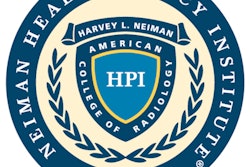
Does ultrasound performed by emergency physicians generate further imaging as radiologists work up suspicious findings first detected by their colleagues in the emergency department (ED)? Researchers from the Harvey L. Neiman Health Policy Institute (HPI) took on this question at the recent RSNA 2017 meeting.
Dr. Van Carroll Jr. from Brookwood Baptist Health in Birmingham, AL, and colleagues from HPI and the American College of Radiology's (ACR) Data Science Institute investigated which ED ultrasound examinations are common to both radiologists and ED practitioners. They also studied the ensuing diagnostic imaging events specific to those services.
Their research was prompted by anecdotal observations from radiology colleagues, Carroll told session attendees.
"We were hearing things like, 'It sure seems like we do a lot more repeat ultrasound studies when the first examination is performed by ED physicians,' and 'We're doing a lot more CT scans when an ultrasound is performed in the ED by ED physicians,' " he said. "So we wanted to explore whether this was, in fact, the case."
Downstream dilemma?
Some studies have suggested that Medicare patients undergo more downstream diagnostic imaging examinations when initial ED ultrasound exams are performed by nonradiologists instead of radiologists, Carroll said.
"We wanted to know whether there were differences in downstream imaging between radiologists and ED physicians," he said.
Carroll and colleagues used claims data from the 5% Medicare Research Identifiable Files from 2010 to 2014 to identify the most common ED ultrasound examinations performed by radiologists and nonradiologists, as well as which examinations performed by nonradiologists were more likely to be performed by ED physicians. The group then determined which services common to radiologists were also likely performed by ED physicians before assessing the frequency of downstream imaging events within 30 days of the initial ED visit and stratifying this additional imaging by provider.
The researchers found that radiologists performed 81.6% of ultrasounds in the ED, while nonradiologist physicians performed 18.4%. Abdominal ultrasound exams were most common for both radiologists and ED physicians: These exams accounted for 38% of noncardiac and nonvascular ultrasound performed by nonradiologists in the ED and 92% of noncardiac and nonvascular ultrasound performed by radiologists in the ED.
Despite the anecdotal observations from radiologists about more downstream imaging after nonradiologist ED ultrasounds, the differences were small and not statistically significant, Carroll and colleagues found. Between 2010 and 2014, the number of mean downstream exams performed within 30 days for nonradiologists after ED abdominal ultrasound was 1.49, while for radiologists it was 1.29.
The group also discovered the following:
- Follow-up complete abdomen ultrasound rates were similar in both groups, but follow-up limited ultrasound (CPT code 76005) was higher among nonradiologists.
- Follow-up abdomen pelvis CT was higher among nonradiologists.
- Follow-up extremity vascular ultrasound was higher among nonradiologists.
- The most common follow-up studies in both groups were chest radiographs, although head CT was also common.
"While there are trends in the data that support the anecdotal observations, these were not statistically significant and much of the follow-up was unrelated to the original examination, which confirms that ED patients often have multifactorial illnesses," Carroll said.
Further research
Carroll acknowledged that the research has limitations: The data used represented only the Medicare population -- and only 5% of it at that, he noted. And if ED physicians are performing only 18% of Medicare ED ultrasound, the findings may not be generalizable to real-world practice.
But the researchers hope the study will spark further research efforts, he concluded.
"We should continue to push for the availability of more complete claims data from a variety of payors, as machine learning is poised to help researchers identify trends in even the largest datasets," he said. "At the institution level, there are opportunities for researchers to look at their own data ... to evaluate these trends in more detail and use the results in quality assurance activities to improve care."




















